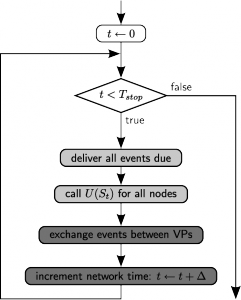Scheduling and simulation flow
Introduction
To drive the simulation, neurons and devices (nodes) are updated in a time-driven fashion by calling a member function on each of them in a regular interval. The spacing of the grid is called the simulation resolution (default 0.1ms) and can be set using SetKernelStatus:
SetKernelStatus("resolution", 0.1)Even though a neuron model can use smaller time steps internally, the membrane potential will only be visible to a multimeter on the outside at time points that are multiples of the simulation resolution.
In contrast to the update of nodes, an event-driven approach is used for the synapses, meaning that they are only updated when an event is transmitted through them (Morrison et al. 2005). To speed up the simulation and allow the efficient use of computer clusters, NEST uses a hybrid parallelization strategy. The following figure shows the basic loop that is run upon a call to Simulate:

Simulation Loop
The simulation loop. Light gray boxes denote thread parallel parts, dark gray boxes denote MPI parallel parts. U(St) is the update operator that propagates the internal state of a neuron or device.
Simulation resolution and update interval
Each connection in NEST has it's own specific delay that defines the time it takes until an event reaches the target node. We define the minimum delay dmin as the smallest transmission delay and dmax as the largest delay in the network. From this definition follows that no node can influence another node during at least a time of dmin, i.e. the elements are effectively decoupled for this interval.

Definitions of the minimimum delay and the simulation resolution.
Definitions of minimum delay (dmin) and simulation resolution (h).
Two major optimizations in NEST are built on this decoupling:
Every neuron is updated in steps of the simulation resolution, but always for dmin time in one go, as to keep neurons in cache as long as possible.
MPI processes only communicate in intervals of dmin as to minimize communication costs.
These optimizations mean that the sizes of spike buffers in nodes and the buffers for inter-process communication depend on dmin+dmax as histories that long back have to be kept. NEST will figure out the correct value of dmin and dmax based on the actual delays used during connection setup. Their actual values can be retrieved using GetKernelStatus:
GetKernelStatus("min_delay") # (A corresponding entry exists for max_delay)Setting dmin and dmax manually
In linear simulation scripts that build a network, simulate it, carry out some post-processing and exit, the user does not have to worry about the delay extrema dmin and dmax as they are set automatically to the correct values. However, NEST also allows subsequent calls toSimulate, which only work correctly if the content of the spike buffers is preserved over the simulations.
As mentioned above, the size of that buffer depends on dmin+dmax and the easiest way to assert its integrity is to not change its size after initialization. Thus, we freeze the delay extrema after the first call to Simulate. To still allow adding new connections inbetween calls to Simulate, the required boundaries of delays can be set manually using SetKernelStatus (Please note that the delay extrema are set as properties of the synapse model):
SetDefaults("static_synapse", {"min_delay": 0.5, "max_delay": 2.5})These settings should be used with care, though: setting the delay extrema too wide without need leads to decreased performance due to more update calls and communication cycles (small dmin), or increased memory consumption of NEST (large dmax).
Spike generation and precision
A neuron fires a spike when the membrane potential is above threshold at the end of an update interval (i.e., a multiple of the simulation resolution). For most models, the membrane potential is then reset to some fixed value and clamped to that value during the refractory time. This means that the last membrane potential value at the last time step before the spike can vary, while the potential right after the step will usually be the reset potential (some models may deviate from this). This also means that the membrane potential recording will never show values above the threshold. The time of the spike is always the time at the end of the interval during which the threshold was crossed.
NEST also has a some models that determine the precise time of the threshold crossing during the interval. Please see the documentation on precise spike time neurons for details about neuron update in continuous time and the documentation on connection management for how to set the delay when creating synapses.
